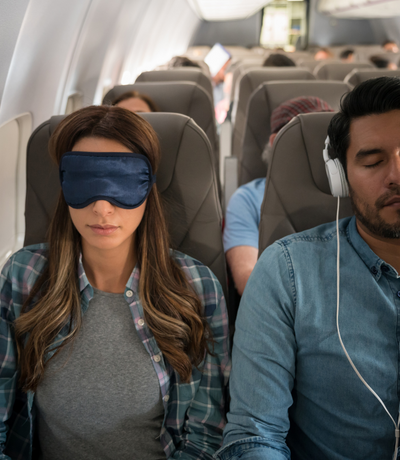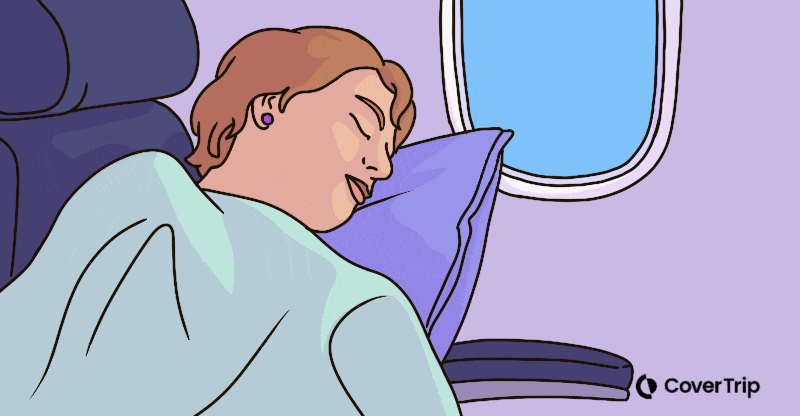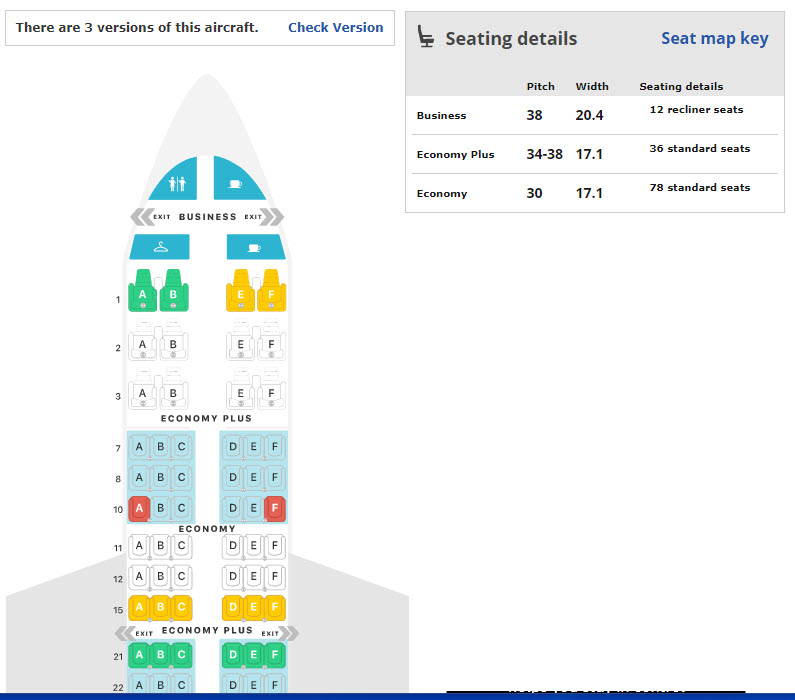How to safely sleep on a plane
8 July 2022
Why is it so hard to sleep on a plane? The combination of seat structure, cabin conditions, and your own confused sleep cycles conspire against you. Sitting upright in an airplane seat is just not the ideal situation for getting good sleep, but it’s not impossible.
In addition to dressing in comfortable layers with natural fabrics, the key to falling asleep on a plane is to maximize your environment and go easy on yourself.
After all, it took a lot of planning and strategizing to book the trip, organize everything, and get yourself on that plane. Now’s the time to chill out and take a breather, right?
Here are the science-backed ways to get a little (even-if-it’s-not-the-best-you-ever-had) sleep on a plane.

Opt for more legroom
If you can’t upgrade your seat to business or first-class, you can still maximize the leg room you have in economy class. Sometimes the upgrade to premium economy is worth a little extra.
You can carefully study the seat map using SeatGuru. Sometimes you can get extra legroom at no extra cost just by how the plane is configured. You can look up the aircraft even before choosing a flight by typing in the airline, date, and flight number.
Pro tip: avoid crossing your legs when you sleep on a plane. It applies pressure, restricts blood flow, and puts you at a higher risk for blood clots.
Get the seat angle right
In an article published on Slate, the American Academy of Sleep Medicine says that leaning back at a 135-degree angle is the safest sleep position. This angle places less pressure on the body, thereby decreasing risk of developing a blood clot.
Using SeatGuru, you can also look up the seat pitch, or the angle at which a seat will recline. See the plane and seating details for an upcoming flight I’m taking:

The flight is overnight, a red-eye, so I’m hoping to sleep through it. For this flight, I’m going to upgrade to Economy Plus to maximize the angle at which my seat will recline.
Pro tip: resting your forearms on the armrests takes some of the pressure off your upper body and spine, so don’t push the armrests out of the way.
Maximize your environment for sleep
A big reason we can’t sleep on planes is all in our heads. Your neck isn’t supported, your eyes are taking in light, and your ears are filled with sound—no one could sleep in that environment!
Here’s how to step-by-step maximize your seat environment for better sleep:
- Stretch before you get on board. Stretching relieves stress and puts you in a restful state. Don’t worry what others think of you forward folding as you wait for your group to be called. You’ll be asleep after take-off and they won’t.
- Stick a rolled up jacket or pillow behind your back. It will support the natural S-curve of your spine and reduce back pain from sitting upright-ish on long flights.
- Sprinkle a few drops of lavender oil on your eye mask. Lavender increases slow-wave sleep, and a good, well-fitted eye mask blocks light.
- Invest in some quality noise-canceling headphones or earplugs to block out all the noise, including that big guy snoring behind you.
- Support your head, and give your neck a break, with a neck pillow or brace. There’s a whole world of options out there, so you’ll want to experiment until you find just the right one.
- Pack your own blanket, so you know it’s soft and clean. Buckle your seatbelt over the blanket so flight attendants won’t wake you for safety checks.
- Wear socks to keep your feet warm, especially if you prefer to take your shoes off to help you sleep. The temperatures in airplanes can fluctuate drastically and either help you sleep or wake you up.
Pro tip: putting on an eye mask and ear plugs is the universally understood ‘Do Not Disturb’ sign, but it doesn’t hurt to gently inform your seatmates that you prefer not to be bothered.
Load a pink noise app on your phone
We’ve heard of white noise machines to help you sleep, but recently discovered pink noise. The difference is that pink noise changes frequency—think ocean waves, wind-rustled leaves, and unsteady rainfall.
A small study published in the National Library of Medicine found pink noise had a significant positive effect on improving sleep stability. You can find pink noise apps on the Apple and Google stores.
Pro tip: plug your phone into a charger and silence notifications that can wake you up on your flight.
Skip the sleeping pills
Prescription and over-the-counter sleeping aids are powerful medications that sometimes cause weird and even embarrassing side effects. Can you imagine a passenger sleepwalking on a plane? It’s happened – flight attendants call them Zolpidem Zombies (zolpidem is sold as Ambien). Plus, if you’re traveling with children, you don’t want to be completely out of it.
You’re better off with natural options like eating foods that help you sleep: bananas, almonds, and cherry juice all have high carbs that aid in slumber. Bananas are also high in magnesium and potassium that help regulate blood pressure and induce sleep. Chamomile tea can also help you fall to sleep naturally. Melatonin can also be a safer sleep aid according to the National Institute of Health, and it alleviates jet-lag too.
Skip the alcohol and caffeine too
Both alcohol and caffeine can disrupt sleep patterns. Alcohol might seem like the answer to falling asleep but scientific studies show it actually leads to more awakenings, poor sleep quality, and less deep sleep. Caffeine and alcohol are both dehydrating elements, which can disturb your sleep and amplify the jet-lag when you land.
Avoid caffeine for 24 hours prior to your flight because it can remain in your body for up to 14 hours, stalling your internal circadian clock and preventing sleep. You can caffeine up when you land for a jolt of wakefulness instead.
Give yourself a break
If you can find a way to be OK with not getting amazing sleep, that will help. There’s almost nothing more stress-inducing than trying to fall asleep and failing at it.
You gotta give yourself a break!
Be happy with just dozing a little or drifting in and out of light sleep, and plan to be a little sleepy the first day of your trip.
Damian Tysdal is the founder of CoverTrip, and is a licensed agent for travel insurance (MA 1883287). He believes travel insurance should be easier to understand, and started the first travel insurance blog in 2006.
